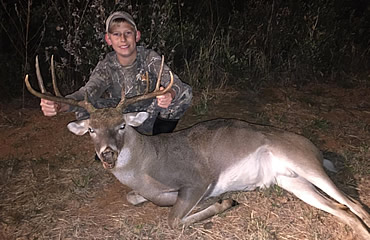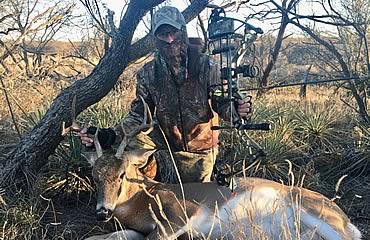Young bowhunter doesn’t make the same mistake twice!
I have been hunting for as long as I can remember. It was a tradition passed down by my father, and I have passed it on to my two boys. My youngest, Hunter, has been at home in the wild since the age of 3 when I took him hunting for turkeys for the first time.
When he was 4, Hunter took his first deer, a doe, with a Savage .223. He took a spike the next year, and at age 6 shot his first mature buck. Since then, he has harvested two dozen other deer and hogs with a variety of rifles.
Those trophies aren’t nearly as important as the lessons he’s learned on that journey. I have chased whitetails for most of my life, but I always learn something new each year. Hunter is light years ahead of where I was at his age. He is as patient and observant as any hunter I have shared time with in the woods.
 Hunter was 11 when he took his first whitetail buck hunting by himself. Since then, he has continued to strive to hunt on his own, picking his own stand locations and choosing what to harvest.
Hunter was 11 when he took his first whitetail buck hunting by himself. Since then, he has continued to strive to hunt on his own, picking his own stand locations and choosing what to harvest.
As much as he loves to hunt with a rifle, Hunter’s passion is really the stick and string. He has been shooting a bow since the time he could pull one back. Archery has been his primary focus over the last few years. He practices at home and has participated in 4-H and other shooting competitions. Only recently (2017) has he been able to pull back 40 pounds, however. That has always been my minimum for hunting whitetails.
Hunter had a few failed opportunities on hogs and deer that first year afield with his bow. His goal for 2018 was to get a deer – any deer – on the ground with his Bowtech.
Thanksgiving day, we headed to a small piece of property we own in the corner of the Texas Panhandle. There is a healthy deer population there, but very little cover. That late in the season, with little to no foliage, it is very difficult to draw on a deer without getting busted. Hunter found that out the hard way on the second evening of our hunt.
 We were set up about a half-mile apart and using radios to keep in touch. Right at dark, he radioed, and I could tell something had happened. I didn’t catch the whole message, but I knew he had experienced a close encounter.
We were set up about a half-mile apart and using radios to keep in touch. Right at dark, he radioed, and I could tell something had happened. I didn’t catch the whole message, but I knew he had experienced a close encounter.
We met up at the cabin after dark, and he proceeded to tell me that two does had come by that evening with a nice buck grunting behind them. It was right in the middle of the rut, so I wasn’t surprised.
He explained that as the does passed by, the buck stopped perfectly broadside at 15 yards. As he drew, Hunter scraped his quiver against a limb in the stand. One of the does heard it and darted downwind. The buck also spooked and moved out of range.
Within a few seconds, the old doe was blowing, every deer in the county was on high alert and a great opportunity had come and gone.
I could see the disappointment on Hunter’s face as I asked what he had learned.
“Not to draw without a clear shot,” he responded.
“Did you have a clear shot?” I asked.
He thought about it for a second, and then said, “I would have if I could have got my bow drawn back.”
I spent the next few minutes explaining that sometimes you have to make a clean draw and then move your point of aim to the target.
“The best path is not always a direct path,” I told him. He got it.
The next morning, he was back it that tree well before daylight. At 7:05, he called me on the radio and could barely talk. Another buck had followed the same trail at daylight and stopped in the same spot.
Hunter told me how he drew cleanly to the left before slowly moving his sights to the buck. The double-lung shot was clean, and the deer made it only about 50 yards.
There were several lessons learned on that hunt, but two of the most important were to learn from your mistakes and get back in a tree.
– If you have a story for Smalltown Bucks, send a text or Word file with pictures to kpiper@buckmasters.com. Please include Smalltown Bucks in the subject line.